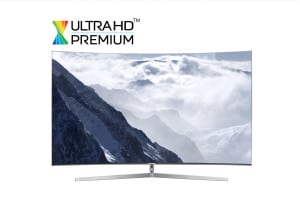Latest News

Samsung’s Ultra-HD certified 4K TV, bearing the logo created and handed out by the UHD Alliance. Photo: Samsung
[Via Satellite 05-06-2016] The Ultra-HD Alliance is turning its sights on expanding the amount of 4K content available to consumers as the revolution begins to take off in earnest. Between 2015 and 2016 the number of 4K TV shipments worldwide is expected to jump from 30 million to 48 million, according to asset management company AllianceBernstein. While many speculated that 4K might end up going the way of 3D TV, TV providers are promising more in the way of Ultra-HD channels to satisfy the demands of resolution-hungry viewers, but some argue that there is not yet enough 4K content on the market.
Across the Ultra-HD ecosystem, companies are cheered on by the dramatically rising numbers of 4K TVs on the market, jumping from just 900 thousand sold in 2013 when the product hit shelves, to the nearly 40 million sold in 2015. Furthermore, in the next two years AllianceBernstein projects the number will hone in on 78 million shipments, promising global 4K penetration will surpass 20 percent this year and near 40 percent in 2018.
In order to unify efforts across the 4K market and ensure that all products meet the same standard as Ultra-HD adoption grows across the consumer base, the UHD Alliance emerged at the Consumer Electronics Show in 2015. The alliance boasts names such as Samsung, Warner Bros., Netflix, DirecTV, Technicolor and countless others who are hoping to use it to ensure that all products meet the same standards across the Ultra-HD ecosystem as it continues to evolve.
In January 2016, the alliance unveiled a consumer-facing logo to identify devices, content and services capable of delivering a premium experience to an exploding Ultra-HD market that is expected to grow eightfold by 2019, according to Mark Turner, vice president of corporate partnerships and strategy at Technicolor, an active member of the UHD Alliance. The logo is reserved for products and services that comply with performance metrics.
“The specifications outlined a set of guidelines that clearly distinguish premium quality ecosystem components — including Ultra-HD content, distribution and devices — while preserving creative intent. The UHD Alliance did this by defining, and then testing against consumers, the performance metrics for resolution, HDR, peak luminance, black levels and wide color gamut among other visual elements. The specifications also offer recommendations for immersive audio and other features,” Turner told Via Satellite.
Devices meeting the UHD Alliance specifications can bear the Ultra-HD Premium logo. Since its inception, more than 30 TV devices bear the Ultra-HD Premium logo, with Samsung’s Ultra-HD Blu-ray player receiving the certification most recently, on May 3. Turner believes this assurance that consumers are accessing a full-featured Ultra-HD experience has helped boost 4K adoption.
“We have seen a rapid rise of interest and adoption of 4K Ultra-HD over the past year, especially as the UHD Alliance announced a specification that has, in effect, provided the industry with a basis for offering premium viewing experiences to audiences,” said Turner.
He admits that the standard alone isn’t pushing the pick up, however, noting that Ultra-HD with HDR is one of the most impactful elements of the format. HDR technology reveals a broader spectrum of light, and provides a mechanism for more closely replicating how the human eye sees things. “This makes it possible, for instance, to view a sporting event and more easily and clearly see players as they go into and out of the shadows cast by a stadium. We have seen, in our demonstrations, extremely positive reactions to HDR images because it makes a huge visual difference for both linear and non-linear content. And that is from both consumers and also the creative industry who view HDR as a sea change in viewing quality, which higher resolution (e.g., 4K) cannot generate alone,” said Turner.
Making sure viewers can access HDR content is the next frontier for the UHD Alliance. While there is a growing amount of content being developed for 4K and HDR, only a small fraction is available for consumption. In this way, Turner believes that it is critical to encourage the industry to adopt an open approach to the market in order to ensure interoperability across the full range of production, distribution and Consumer Equipment (CE) devices as well as lay the foundation for single-stream backwards compatibility. In particular, he believes there is a huge opportunity for the industry to re-master Standard Dynamic Range (SDR) libraries in HDR while also deploying technology that can automatically “up-convert” SDR content that is transmitted to audiences into HDR.
“Even though there is a lot of action and adoption around 4K Ultra-HD, HDR and other technologies, we can expect to see a significant percentage of the households to still operate legacy devices. From both a technology management and economic justification perspective, we cannot create a situation in which producers and distributors of content have to maintain two separate technology infrastructures,” Turner said.
He is hoping that with the UHD Alliance working toward an open standard, the industry can avoid backlash from the consumer base that is anticipating access to Ultra-HD content.
“We learned a key lesson in the early days of 4K deployment about how easily consumers can become frustrated if they do not have access to the content they expect when they purchase their next-generation consumer devices,” noted Turner.
Get the latest Via Satellite news!
Subscribe Now